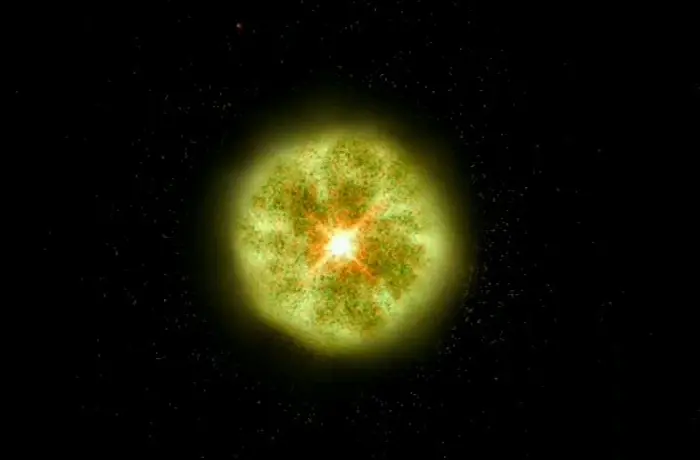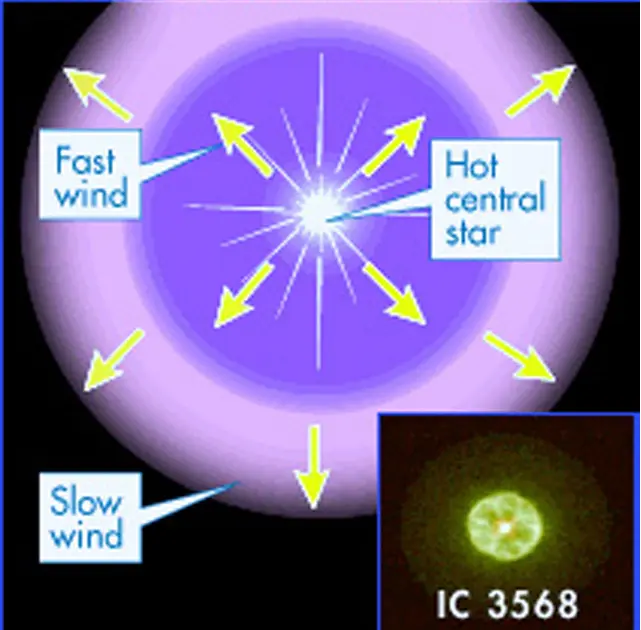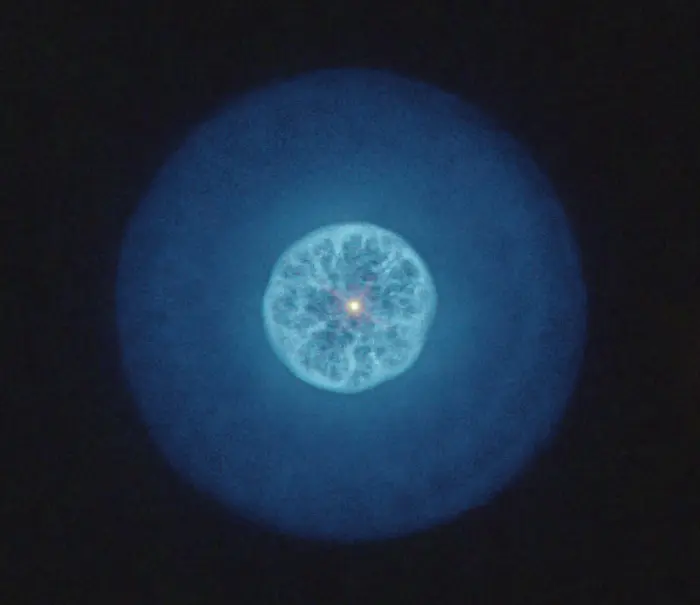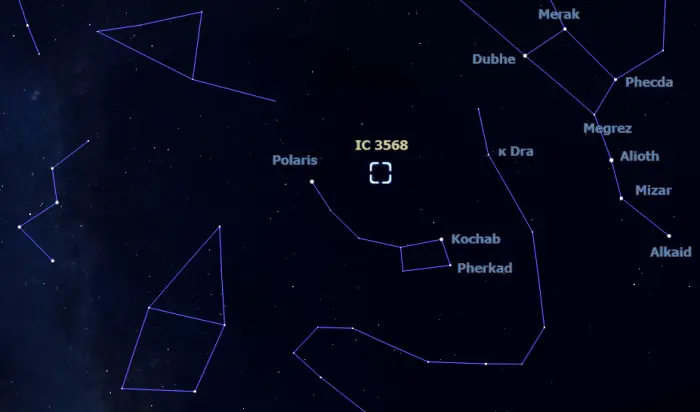The Lemon Slice Nebula is a planetary nebula located approximately 4,500 light-years away in the constellation Camelopardalis. It lies in the region of the north celestial pole, only 7.5 degrees from Polaris. It has the designation IC 3568 in the Index Catalogue.
IC 3568 has an apparent magnitude of 12.3 and an apparent size of 0.350 by 0.315 arcminutes. It is a young nebula with a core diameter of only 0.4 light-years. While this is about 800 times the size of the solar system, it indicates that the gaseous layers expelled from the central star have not had much time to expand. The nebula is composed of less than 1 solar mass of material ejected over the past several thousand years.
In images, the inner region of IC 3568 resembles a sliced lemon, which is how the nebula got its popular nickname. The resemblance was reinforced in a false colour Hubble image released in December 1997.

The Lemon Slice Nebula (IC 3568), credit: ESA, NASA, Hubble
A 2020 study gave an estimated age of 7,500 years and a radius of 0.092 parsecs (0.3 light-years) for the nebula based on the data in the Gaia Early Data Release 3 (EDR3). Planetary nebulae are typically 1 light-year across. Only about 20% of them are spherically symmetrical.
The Lemon Slice Nebula has an almost perfectly round shape. It consists of a bright inner shell surrounded by a larger, fainter outer envelope. The inner shell has a complex structure while the outer shell is exceptionally smooth. The inner shell has an apparent diameter of only 6 arcseconds, while the halo is 18 arcseconds across. The multiple shells reflect the evolution of the central star, which periodically shed material as it came to the end of its life.
The Lemon Slice Nebula formed when an intermediate-mass star came to the end of its life cycle and started losing mass at an increased rate. As the aging red giant continued to expel material, its core contracted and started radiating energy again. As the star heated up, its ultraviolet radiation started to ionize the surrounding gas clouds, causing them to emit light and producing the planetary nebula.
Planetary nebulae are relatively short-lived phenomena. They only last about 20,000 years. Eventually, the expelled layers will dissipate into the surrounding space and the central star will cool and fade as a white dwarf.

Illustration of the Lemon Slice Nebula, credit: NASA & ESA
Facts
The Lemon Slice Nebula was discovered by the American astronomer Robert Grant Aitken on August 31, 1900. At the time, Aitken was observing the Comet Borrelly-Brooks using the 12’’ Clark Refractor at the Lick Observatory on Mount Hamilton, California. He noticed that the star BD +83° 357 was surrounded by a small nebula and confirmed his discovery the following night with the 36-inch Great Lick Refractor.
The nebula was mistakenly listed as a compact galaxy in the Uppsala General Catalogue. It has the catalogue designation UGC 7731.

The Lemon Slice Nebula, image credit: Judy Schmidt (CC BY 2.0)
Location
The Lemon Slice Nebula lies in the faint constellation Camelopardalis, the Giraffe. It appears in the region between the Little Bear’s tail and the Dragon’s tail, about a third of the way from Polaris to Kappa Draconis, one of the stars in the tail of Draco.
Polaris can be identified using the bright stars of the Big Dipper. A line drawn from Merak through Dubhe points in the general direction of the North Star. The fainter Kappa Draconis (mag. 3.8) is the brightest star on the imaginary line connecting Kochab in the Little Dipper and Merak in the Big Dipper.

The location of the Lemon Slice Nebula (IC 3568), image: Stellarium
The Lemon Slice Nebula may be spotted in a small telescope, but it requires clear, dark skies. The inner shell has an angular size comparable to that of the planet Uranus and is best observed in larger instruments at high magnification. The nebula’s faint halo is only visible in larger telescopes.
At declination +82° 34′, the Lemon Slice Nebula is close enough to the north celestial pole to be circumpolar for most observers in the northern hemisphere. The nebula is largely invisible from the southern hemisphere. It never rises above the horizon for observers south of the latitude 7° S.
The best time of the year to observe the Lemon Slice Nebula and other deep sky objects in Camelopardalis is during the month of February, when the constellation appears higher above the horizon in the early evening.
Lemon Slice Nebula – IC 3568
| Constellation | Camelopardalis |
| Object type | Planetary nebula |
| Right ascension | 12h 33m 06.8549162136s |
| Declination | +82° 33′ 50.202643608″ |
| Apparent magnitude | 12.3 |
| Apparent size | 0.350 x 0.315 arcminutes |
| Distance | 4,500 light-years |
| Radius | 0.2 light-years |
| Names and designations | Lemon Slice Nebula, IC 3568, Perek-Kohoutek 123+34.1 (PK 123+34.1), PN VV 63, PN VV’ 111, ARO 56, PN G123.6+34.5, PK 123+34 1, HD 109540, AG+82 365, BD+83 357, PPM 2164, GCRV 7565, IRAS 12317+8250, 2MASX J12330668+8233506, NVSS J123306+823350, UCAC4 863-006931, UGC 7731, TYC 4633-1523-1, Gaia DR2 1720138697015345024, Gaia DR3 1720138697015345024 |